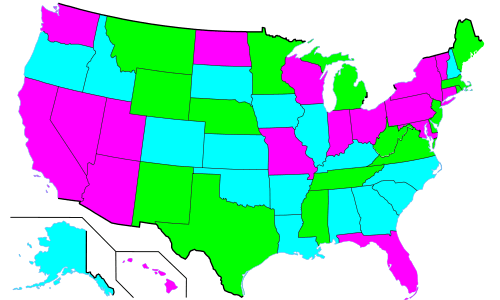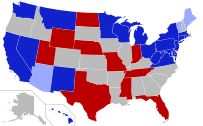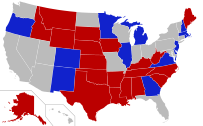Classes of United States senators facts for kids
The United States Senate has 100 seats. These seats are divided into three groups, called "classes." This system helps decide which Senate seats are up for election every two years. Instead of all 100 senators being elected at the same time every six years, only about one-third of the seats are voted on. This happens during presidential or midterm election years.
Each state has two senators. These two senators are always in different classes. This means their terms end in different years. Class 1 and Class 2 each have 33 seats. Class 3 has 34 seats. Elections for Class 1 seats happened in 2024. Elections for Class 2 will be in 2026, and for Class 3 in 2028.
The idea for these three classes comes from Article I, Section 3, Clause 2 of the U.S. Constitution. The first division of senators into classes was done by drawing lots in May 1789. When a new state joined the United States, its two Senate seats were also assigned to different classes by a random draw. This made sure the three classes stayed as close to the same size as possible.
These classes only apply to regular six-year elections. If a senator leaves office early, for example, by resigning or passing away, a special election might be held. This can happen at any time, no matter which class the seat belongs to.
A senator being called "junior" or "senior" does not relate to their class. Instead, a state's senior senator is the one who has served longer in the Senate.
Contents
How Senate Classes Began
The Constitution's Plan
The U.S. Constitution says that senators serve for six years. It also planned for their elections to be staggered. This means about one-third of the Senate is elected every two years. This system helps keep the Senate stable. It encourages senators to think carefully about new laws over time. It prevents the entire group from changing all at once every six years. It also makes sure there are regular elections, so senators don't stay in power for too long without facing voters.
Article I, Section 3 of the U.S. Constitution explains the three classes:
Immediately after they shall be assembled in Consequence of the first Election, they shall be divided as equally as may be into three Classes. The Seats of the Senators of the first Class shall be vacated at the Expiration of the second Year, of the second Class at the Expiration of the fourth Year, and of the third Class at the Expiration of the sixth Year, so that one third may be chosen every second Year.
The first Senate met in May 1789. There were only twenty senators from ten states at that time. On May 11, 1789, a committee was formed to figure out how to divide the senators into classes. On May 14, the Senate decided to divide its members into three classes. They used a lottery system to assign senators to each class.
On May 15, 1789, the senators drew lots to decide when each class's term would end. For example, one class's terms would end after two years, another after four years, and the last after six years. After a senator's term ends, a new six-year term begins for the person elected to that seat. At first, state legislatures chose senators. Later, the Seventeenth Amendment made it so people directly vote for their senators.
Adding New States to the Union
When a new state joins the United States, its two senators are placed into different classes. This is done to keep the three classes as balanced as possible. A random draw decides which new senator goes into which class. This means one of the new state's first senators might serve a term of 2 to 6 years, and the other a shorter term.
New York was the first state to go through this process in July 1789. Philip Schuyler drew the lot for Class 1, and Rufus King drew for Class 3. This made Class 1 have 8 senators, while Classes 2 and 3 had 7 each. North Carolina then joined Classes 2 and 3 in November 1789, making all three classes have 8 seats.
When Hawaii became the newest state in 1959, its first senators, Hiram Fong and Oren E. Long, drew lots. One joined Class 1, and the other joined Class 3. If a 51st state were to join, its senators would be placed in Classes 1 and 2. This would make all three classes have 34 senators.
Because each state has two senators, no matter its population, the number of people each class represents can vary. For example, senators from Class 2 together represent about 50-60% of the U.S. population. Senators from Classes 1 and 3 each represent about 70-75% of the population. This adds up to more than 100% because each person is represented by two senators. Some of the largest states, like California and New York, have their senators in Classes 1 and 3, which causes this difference.
The only times both of a state's Senate seats are up for election in the same year are when a new state joins or when there's a special election to fill an empty seat. Special elections don't change the class of the seat. A senator elected in a special election serves the rest of the original term.
Class 1 Senators
Class 1 includes 33 Senate seats. The next election for these seats will be in November 2030. Their terms will end on January 3, 2031.
The most recent election for Class 1 senators was in 2024.
States with a Class 1 senator: Arizona, California, Connecticut, Delaware, Florida, Hawaii, Indiana, Maine, Maryland, Massachusetts, Michigan, Minnesota, Mississippi, Missouri, Montana, Nebraska, Nevada, New Jersey, New Mexico, New York, North Dakota, Ohio, Pennsylvania, Rhode Island, Tennessee, Texas, Utah, Vermont, Virginia, Washington, West Virginia, Wisconsin, and Wyoming.
Class 2 Senators
Class 2 includes 33 Senate seats. The next election for these seats will be in November 2026. Their terms will end on January 3, 2027.
The most recent election for Class 2 senators was in 2020.
States with a Class 2 senator: Alabama, Alaska, Arkansas, Colorado, Delaware, Georgia, Idaho, Illinois, Iowa, Kansas, Kentucky, Louisiana, Maine, Massachusetts, Michigan, Minnesota, Mississippi, Montana, Nebraska, New Hampshire, New Jersey, New Mexico, North Carolina, Oklahoma, Oregon, Rhode Island, South Carolina, South Dakota, Tennessee, Texas, Virginia, West Virginia, and Wyoming.
Class 3 Senators
Class 3 includes 34 Senate seats. The next election for these seats will be in November 2028. Their terms will end on January 3, 2029.
The most recent election for Class 3 senators was in 2022.
States with a Class 3 senator: Alabama, Alaska, Arizona, Arkansas, California, Colorado, Connecticut, Florida, Georgia, Hawaii, Idaho, Illinois, Indiana, Iowa, Kansas, Kentucky, Louisiana, Maryland, Missouri, Nevada, New Hampshire, New York, North Carolina, North Dakota, Ohio, Oklahoma, Oregon, Pennsylvania, South Carolina, South Dakota, Utah, Vermont, Washington, and Wisconsin.
Senate Election Schedule
This table shows when elections for each class of senators happen.
| Class | Most recent election year |
Next scheduled election year |
|---|---|---|
| Class 1 | 2024 | 2030 |
| Class 2 | 2020 | 2026 |
| Class 3 | 2022 | 2028 |
Comparing with Other U.S. Elections
| Year | 2022 | 2023 | 2024 | 2025 | 2026 |
|---|---|---|---|---|---|
| Type | Midterm | Off-yeara | Presidential year | Off-yearb | Midterm |
| President | No | Yes | No | ||
| Senate | Class III (34 seats) | No | Class I (33 seats) | No | Class II (33 seats) |
| House | All 435 seats[3] | No | All 435 seats[2] | No | All 435 seats[2] |
| Governor | 36 states, DC, & 3 territories[4] AL, AK, AZ, AR, CA, CO, CT, FL, GA, HI, ID, IL, IA, KS, ME, MD, MA, MI, MN, NE, NV, NH, NM, NY, OH, OK, OR, PA, RI, SC, SD, TN, TX, VT, WI, WY, DC (Mayor), GU, MP, VI |
3 states KY, LA, MS |
11 states, 2 territories DE, IN, MO, MT, NH, NC, ND, UT, VT, WA, WV, AS, PR |
2 states NJ, VA |
36 states, DC, & 3 territories[4] AL, AK, AZ, AR, CA, CO, CT, FL, GA, HI, ID, IL, IA, KS, ME, MD, MA, MI, MN, NE, NV, NH, NM, NY, OH, OK, OR, PA, RI, SC, SD, TN, TX, VT, WI, WY, DC (Mayor), GU, MP, VI |
| Lieutenant Governor[5] | 10 states [6] AL, AR, CA, GA, ID, NV, OK, RI, TX, VT |
2 states LA, MS |
5 states, 1 territory DE, MO, NC, VT, WA, AS |
1 state VA |
10 states [6] AL, AR, CA, GA, ID, NV, OK, RI, TX, VT |
| Secretary of State | 26 states AL, AZ, AR, CA, CO, CT, GA, ID, IL, IN, IA, KS, MA, MI, MN, NE, NV, NM, ND, OH, RI, SC, TX, VT, WI, WY |
2 states KY, MS |
8 states MO, MT, NC, OR, PA, VT, WA, WV |
None | 26 states AL, AZ, AR, CA, CO, CT, GA, ID, IL, IN, IA, KS, MA, MI, MN, NE, NV, NM, ND, OH, RI, SC, TX, VT, WI, WY |
| Attorney General | 29 states, DC, & 2 territories AL, AZ, AR, CA, CO, CT, FL, GA, ID, IL, IA, KS, MD, MA, MI, MN, NE, NV, NM, NY, ND, OH, OK, RI, SC, TX, VT, WI, WY, DC, GU, MP |
2 states KY, MS |
10 states IN, MO, MT, NC, OR, PA, UT, VT, WA, WV |
1 state VA |
29 states, DC, & 2 territories AL, AZ, AR, CA, CO, CT, FL, GA, ID, IL, IA, KS, MD, MA, MI, MN, NE, NV, NM, NY, ND, OH, OK, RI, SC, TX, VT, WI, WY, DC, GU, MP |
| State Treasurer[7] | 23 states AL, AZ, AR, CA, CO, CT, FL (CFO), ID, IL, IN, IA, KS, MA, NE, NV, NM, OH, OK, RI, SC, VT, WI, WY |
2 states KY, MS |
9 states MO, NC, ND, OR, PA, UT, VT, WA, WV |
None | 23 states AL, AZ, AR, CA, CO, CT, FL (CFO), ID, IL, IN, IA, KS, MA, NE, NV, NM, OH, OK, RI, SC, VT, WI, WY |
| State Comptroller/Controller | 8 states CA, CT, IL, MD, NV, NY, SC, TX |
None | None | None | 8 states CA, CT, IL, MD, NV, NY, SC, TX |
| State Auditor | 15 states AL, AR, DE, IN, IA, MA, MN, MO, NE, NM, OH, OK, SD, VT, WY |
1 state KY |
9 states MT, NC, ND, PA, UT, VT, WA, WV, GU |
None | 15 states AL, AR, DE, IN, IA, MA, MN, MO, NE, NM, OH, OK, SD, VT, WY |
| Superintendent of Public Instruction | 8 states AZ, CA, GA, ID, OK, SC, SD (incl. Land), WY |
None | 4 states MT, NC, ND, WA |
1 state WI |
8 states AZ, CA, GA, ID, OK, SC, SD (incl. Land), WY |
| Agriculture Commissioner | 7 states AL, FL, GA, IA, ND, SC, TX |
2 states KY, MS |
2 states NC, WV |
None | 7 states AL, FL, GA, IA, ND, SC, TX |
| Insurance Commissioner | 5 states DE, CA GA, KS, OK, |
2 states LA, MS |
3 states NC, ND, WA, |
None | 5 states DE, CA GA, KS, OK, |
| Other commissioners & elected officials | 8 states AZ (Mine Inspector), AR (Land), GA (Land), NM (Land), ND (Tax), OK (Labor), OR (Labor), TX (Land) |
None | 1 state NC (Labor) |
None | 8 states AZ (Mine Inspector), AR (Land), GA (Land), NM (Land), ND (Tax), OK (Labor), OR (Labor), TX (Land) |
| State legislatures[8] | 46 states, DC, & 4 territories AK, AL, AZ, AR, CA, CO, CT, DE, FL, GA, HI, ID, IL, IN, IO, KS, KY, ME, MA, MD, MI, MN, MO, MN, NE, NV, NH, NM, NY, NC, ND, OH, OK, OR, PA, RI, SC, SD, TN, TX, UT, VT, WA, WV, WI, WY, DC, AS, GU, MP, VI |
4 states LA, MS, NJ, VA |
44 states, DC, & 5 territories AK, AZ, AR, CA, CO, CT, DE, FL, GA, HI, ID, IL, IN, IO, KS, KY, ME, MA, MI, MN, MO, MN, NE, NV, NH, NM, NY, NC, ND, OH, OK, OR, PA, RI, SC, SD, TN, TX, UT, VT, WA, WV, WI, WY, DC, AS, GU, MP, PR, VI |
2 states VA, NJ |
46 states, DC, & 4 territories AK, AL, AZ, AR, CA, CO, CT, DE, FL, GA, HI, ID, IL, IN, IO, KS, KY, ME, MA, MD, MI, MN, MO, MN, NE, NV, NH, NM, NY, NC, ND, OH, OK, OR, PA, RI, SC, SD, TN, TX, UT, VT, WA, WV, WI, WY, DC, AS, GU, MP, VI |
| State boards of education [9] | 8 states, DC, & 3 territories AL, CO, KS, MI, NE, OH, TX, UT, DC, GU, MP, VI |
None | 8 states, DC, & 3 territories AL, CO, KS, MI, NE, OH, TX, UT, DC, GU, MP, VI |
None | 8 states, DC, & 3 territories AL, CO, KS, MI, NE, OH, TX, UT, DC, GU, MP, VI |
| Other state, local, and tribal offices | Varies | ||||
- 1 This table does not include special elections, which may be held to fill political offices that have become vacant between the regularly scheduled elections.
- 2 As well as all six non-voting delegates of the U.S. House.
- 3 As well as five non-voting delegates of the U.S. House. The Resident Commissioner of Puerto Rico instead serves a four-year term that coincides with the presidential term.
- 4 The Governors of New Hampshire and Vermont are each elected to two-year terms. The other 48 state governors and all five territorial governors serve four-year terms.
- 5 In 26 states and 3 territories the Lieutenant Governor is elected on the same ticket as the Governor: AK, CO, CT, FL, HI, IL, IN, IA, KS, KY, MD, MA, MI, MN, MT, NE, NJ, NM, NY, ND, OH, PA, SC, SD, UT, WI, GU, MP, VI.
- 6 Like the Governor, Vermont's other officials are each elected to two-year terms. All other state officers for all other states listed serve four-year terms.
- 7 In some states, the comptroller or controller has the duties equivalent to a treasurer. There are some states with both positions, so both have been included separately.
- 8 This list does not differentiate chambers of each legislature. Forty-nine state legislatures are bicameral; Nebraska is unicameral. Additionally, Washington, DC, Guam, and the US Virgin Islands are unicameral; the other territories are bicameral. All legislatures have varying terms for their members. Many have two-year terms for the lower house and four-year terms for the upper house. Some have all two-year terms and some all four-year terms. Arkansas has a combination of both two- and four-year terms in the same chamber.
- 9 Most states not listed here have a board appointed by the Governor and legislature. All boards listed here have members that serve four-year staggered terms, except Colorado, which has six-year terms, and Guam, which has two-year terms. Most are elected statewide, some are elected from districts. Louisiana, Ohio, Guam, and the Northern Mariana Islands have additional members who are appointed.
Current Senators by Class
This table shows how many senators from each political party are in each class.
|
This table lists the senators by state and by class. It also includes the state's Cook Partisan Voting Index (PVI). The PVI shows how much a state tends to vote for one political party over another.
|
See also
 In Spanish: Clases de senadores de los Estados Unidos para niños
In Spanish: Clases de senadores de los Estados Unidos para niños





